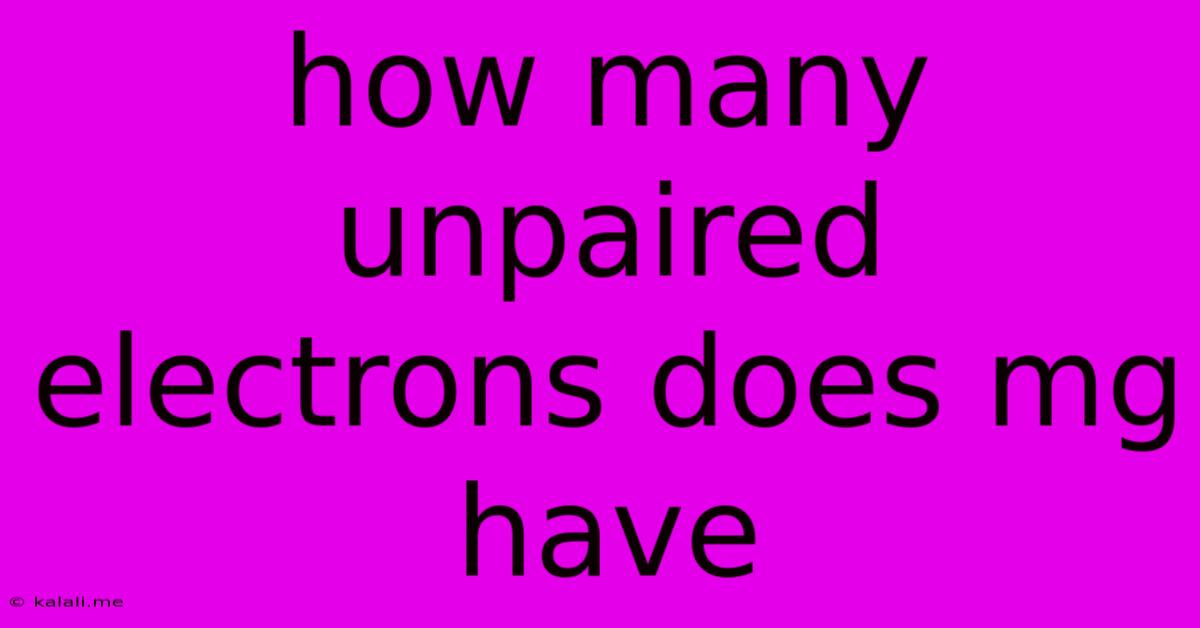How Many Unpaired Electrons Does Mg Have
Kalali
Jun 14, 2025 · 2 min read

Table of Contents
How Many Unpaired Electrons Does Magnesium Have? A Deep Dive into Electronic Configuration
Magnesium, a vital element in human biology and various industrial applications, possesses a fascinating electronic structure that dictates its chemical properties. Understanding its electron configuration is key to determining the number of unpaired electrons it holds. This article will delve into the intricacies of magnesium's atomic structure, explaining how to determine its number of unpaired electrons. Learn about electron shells, orbitals, and the principles behind electron pairing.
Magnesium (Mg) has an atomic number of 12, meaning it has 12 protons and 12 electrons in a neutral atom. To find the number of unpaired electrons, we need to examine its electronic configuration, which describes how these electrons are distributed among different energy levels and orbitals within the atom.
Understanding Electron Configuration
Electrons occupy specific energy levels or shells around the nucleus. Each shell can hold a maximum number of electrons. The first shell (n=1) can hold up to two electrons, the second shell (n=2) can hold up to eight, and so on. Within each shell are subshells (s, p, d, f), each accommodating a specific number of electrons.
- The s subshell: Holds a maximum of 2 electrons.
- The p subshell: Holds a maximum of 6 electrons.
- The d subshell: Holds a maximum of 10 electrons.
- The f subshell: Holds a maximum of 14 electrons.
Electrons fill orbitals following Hund's rule, which states that electrons will individually occupy each orbital within a subshell before doubling up in any one orbital. This minimizes electron-electron repulsion. Orbitals are regions of space within a subshell where an electron is most likely to be found.
Magnesium's Electronic Configuration
Magnesium's electronic configuration is written as 1s²2s²2p⁶3s². Let's break it down:
- 1s²: Two electrons fill the first shell's s subshell.
- 2s²: Two electrons fill the second shell's s subshell.
- 2p⁶: Six electrons fill the second shell's p subshell (three orbitals, each with two electrons).
- 3s²: Two electrons fill the third shell's s subshell.
Determining the Number of Unpaired Electrons
Notice that all the electrons in magnesium's configuration are paired. Each orbital within the s and p subshells contains two electrons with opposite spins. Therefore, magnesium has zero unpaired electrons.
Implications of Magnesium's Electronic Structure
The absence of unpaired electrons explains why magnesium is a relatively unreactive metal compared to elements with unpaired electrons. These unpaired electrons are highly reactive and readily participate in chemical bonding. Magnesium's stability contributes to its role in biological processes and its use in various alloys.
Conclusion
In summary, magnesium (Mg) with an atomic number of 12 has an electronic configuration of 1s²2s²2p⁶3s². Because all its electrons are paired, magnesium has zero unpaired electrons. This characteristic significantly impacts its chemical behavior and overall properties. Understanding electronic configurations is crucial for predicting the chemical reactivity and behavior of elements.
Latest Posts
Latest Posts
-
What Is The Difference Between Observations And Inferences
Jun 15, 2025
-
Which Digestive Enzyme Hydrolyzes Protein In The Stomach
Jun 15, 2025
-
Which Of The Following Statements Best Describes Scientific Research
Jun 15, 2025
-
Applications Of Series And Parallel Circuits
Jun 15, 2025
-
35 Is What Percent Of 105
Jun 15, 2025
Related Post
Thank you for visiting our website which covers about How Many Unpaired Electrons Does Mg Have . We hope the information provided has been useful to you. Feel free to contact us if you have any questions or need further assistance. See you next time and don't miss to bookmark.